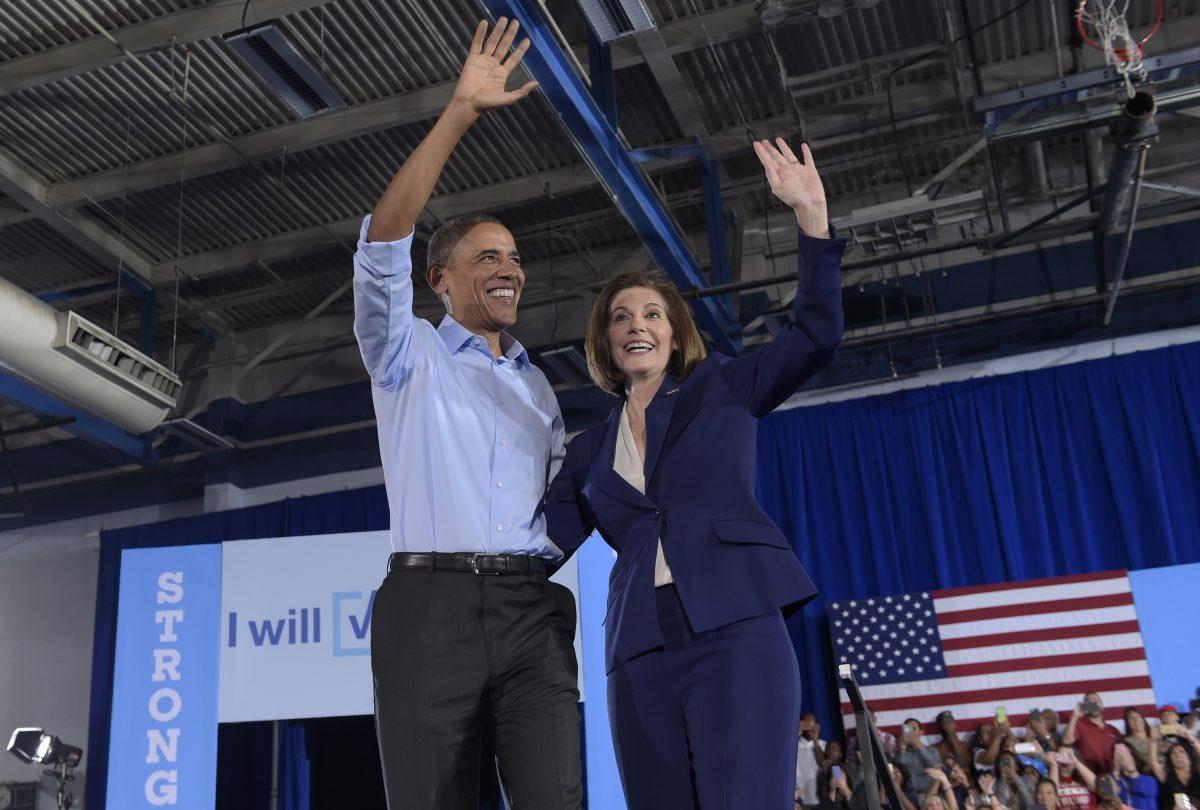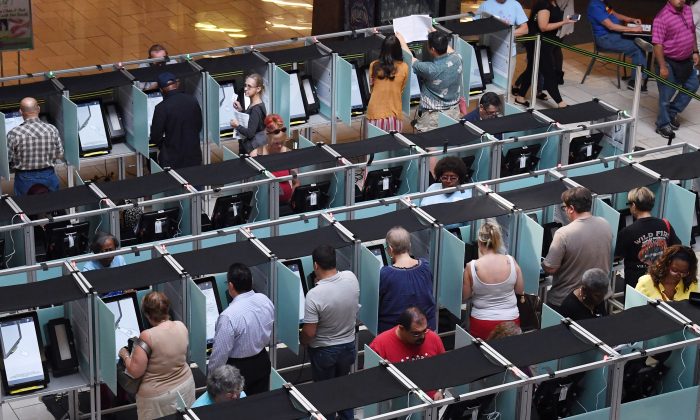Early voting runs from Oct. 19 to Nov. 1 in the swing state, which Trump hopes to turn red for the first time since 2004.
When Nevada’s early-voting period kicks off on Oct. 19, both parties will aggressively seek to secure their base votes, but the biggest prize in the smallest of the nation’s seven battleground states will be getting nonpartisan voters to the polls.
At stake in the triple-tier battleground state are Nevada’s six electoral college votes and U.S. Senate and House races that could determine which party controls Congress in January 2025.
The focus will be on Clark County, which includes Las Vegas, North Las Vegas, and Henderson, where about 70 percent of the state’s 3.2 million residents live and three of its four congressional districts are located.
As of Oct. 1, the Nevada secretary of state’s office reports that nearly 1.73 million of Clark County’s 2.34 million residents are registered to vote. There are fewer than 700,000 registered voters elsewhere statewide, with more than half in Washoe County, where Reno is.
Democrats have an advantage of nearly 140,000 registered voters over Republicans in Clark County, but they are outnumbered by 90,000 registered GOP voters outside the Las Vegas area.
The biggest bloc of voters in Clark County and statewide, however, is nonpartisan.
More than 825,000 Nevadans—including 620,000 in Clark County—are registered to vote but not as a member of any party.
Add more than 180,000 third-party voters to the nonpartisan bloc, and more than 1 million of Nevada’s 2.4 million registered voters—and more than 950,000 of Clark County’s 1.73 million registered voters—are potentially up for grabs.
Galvanizing turnout for the Oct. 19 to Nov. 1 early in-person voting period and encouraging voters to cast mail-in ballots—all Nevada registered voters will receive their ballots by mail from Oct. 16 to Oct. 22—are key strategies for winning any race in a state where less than 15 percent of voters typically cast their ballots on Election Day.
Former President Barack Obama will be in Las Vegas on Oct. 19 to rally Democrats to get voters to the polls during the first day of the two-week early-voting period.
It is Obama’s first campaign-related visit to Nevada in support of the Democratic Party’s ticket this election cycle and follows his Oct. 18 stump in Tucson, Arizona, and his Oct. 10 rally in Pittsburgh.
The three states are among the seven battleground states where forecasters and pundits say the 2024 presidential election between Vice President Kamala Harris and former President Donald Trump will be determined.
An Emerson College polling/8 News Now/The Hill poll released Oct. 10 showed Harris leading by less than 1 percent in Nevada. Others indicate Trump has a slight edge. All polls give him a good chance to be the first Republican to win a Nevada presidential election since President George W. Bush did so in 2004.
In 2020, then-Vice President Joe Biden beat Trump by 2.39 percentage points—less than 34,600 votes—in Nevada. Democrats had a 110,000-voter registration advantage statewide that November.
Of the 1.425 million Nevadans who voted in the 2020 election, about 690,000 did so by mail, with about 500,000 casting ballots for Biden. Of the 578,428 who voted early, about 300,000 voted for Trump. Fewer than 160,000 people voted on Election Day.
Overall, nearly 77 percent of Democrats turned out, more than 81 percent of Republicans cast ballots, and about 65 percent of nonpartisan/third-party voters hit the polls, according to the secretary of state’s office.
While Republicans routinely have a turnout advantage of 4 percentage points to 5 percentage points in Nevada, Democrats’ numerical edge—their Clark County “firewall”—has lifted their candidates to victories.
That blue bulge has eroded significantly in the past four years. Democrats’ 110,000 registration advantage over Republicans in 2020 declined to about 80,000 in 2022. As of Jan. 1, 2024, it was under 60,000. On Oct. 1, it was less than 45,000.
During the 2022 midterms, Republicans had a near-12 percentage point turnout advantage over Democrats, but three Democratic House incumbents and Sen. Catherine Cortez Masto (D-Nev.) eked out wins by an average 3 percentage points because of their numerical advantage.
Democrats were also able to maintain their state legislature majorities, although former Clark County Sheriff Joe Lombardo, a Republican, was elected governor, unseating incumbent Gov. Steve Sisolak.

Republicans are gaining in the Silver State primarily because, as polls indicate, residents are most concerned about the economy, according to a Sept. 19 USA Today/Suffolk University poll.
Nevada has the nation’s highest state unemployment rate, and inflation and housing costs are top issues.
Trump introduced his “no taxes on tips” campaign initiative during an August rally in Las Vegas, and Harris matched the proposal a month later, also during a Las Vegas stump.
More than 30 percent of the state’s population is Latino, and they are the backbone of Nevada’s gaming and hospitality industry. Biden won 61 percent of Nevada’s Latino vote to Trump’s 35 percent in 2020, according to The Nevada Independent.
According to an October USA Today/Suffolk University poll of Latino voters, Trump has whittled nearly 12 percentage points off that advantage and is routinely polling at about 40 percent in his race against Harris.
That difference could be pivotal in Trump’s winning a state that he lost by less than 2.4 percentage points four years ago with just 35 percent of the Latino vote.
Harris did a national town hall hosted by Univision in Las Vegas on Oct. 10, and two days later, Trump did a Hispanic roundtable in Henderson.
Many of the state’s Latino voters, and many who have come to the fast-growing state to work in the gaming and hospitality industry, are among Nevada’s 825,000 nonpartisan voters.
Many were registered to vote automatically when they got driver’s licenses or ID cards at the Department of Motor Vehicles. They did not register with a party and thus were auto-registered as nonpartisan.
The 65 percent 2020 nonpartisan/third-party turnout was 20 percent to 25 percent higher than what is typical for a constituency that is often not politically engaged.
And these voters will determine who wins the Nov. 5 elections in Nevada.
That is why Obama will be in town to kick-start the early-vote drive that Democrats need, not only to fire up the party’s base but also to galvanize its ground game in Las Vegas to ferret out nonpartisan voters and get them to the polls or to cast their mail-in ballots.
Obama remains popular in Nevada, and his campaign-related rallies draw huge crowds. He won the state by more than 12 percentage points in 2008, the largest margin of victory in any presidential race this century, and by 7 percentage points in 2012.
The former president rallied for Cortez Masto and the three Democratic House incumbents in November 2022 and for Biden in 2020.
Obama’s swing through western battleground states is part of a broader Harris campaign effort that will see former President Bill Clinton stumping in Georgia Oct. 20 and Oct. 21 before embarking on a North Carolina bus tour.

